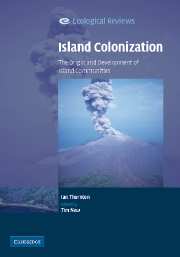Book contents
- Frontmatter
- Contents
- Editorial preface
- Acknowledgements
- PART I Theoretical and experimental studies
- PART II Natural recolonization after devastation
- PART III The recolonization of devastated islands
- PART IV Assembly of biotas on new islands
- PART V Colonization and assembly
- 14 Dispersal
- 15 Stepping stone islands: the case of Sebesi
- 16 Learning from nature's lessons
- References
- Index
16 - Learning from nature's lessons
Published online by Cambridge University Press: 12 January 2010
- Frontmatter
- Contents
- Editorial preface
- Acknowledgements
- PART I Theoretical and experimental studies
- PART II Natural recolonization after devastation
- PART III The recolonization of devastated islands
- PART IV Assembly of biotas on new islands
- PART V Colonization and assembly
- 14 Dispersal
- 15 Stepping stone islands: the case of Sebesi
- 16 Learning from nature's lessons
- References
- Index
Summary
Community development
Studies of oceanic islands and archipelagos that are millions of years old, such as the Galapagos and Hawaii, can often provide evidence about the dispersal sieves, and sometimes the establishment constraints, that operated in the build-up of island biotas from a zero base (e.g. Thornton 1971, Becker 1975, 1992, Carlquist 1996, Peck 1996). The only good comparison between oceanic and continental islands of similar size in the same region has been by Case and Cody (1987) in the Sea of Cortez. This study was particularly illuminating. They found no difference between continental and oceanic islands in the species richness of land plants, land birds and shore fish, but that land mammals and reptiles were richer on the continental islands. They interpreted this to mean that the two latter groups had not yet declined to equilibrium numbers on the continental islands. Could it also be that these relatively poor dispersers have not yet risen to equilibrium on the oceanic ones?
The relative simplicity of Anak Krakatau's developing community has permitted investigations of the role of particular species in the process of community assembly. For example, Gross (1993) has elucidated the dependence of the pioneer leguminous creeper, Canavalia rosea, on its carpenter bee pollinator, Xylocopa confusa, and Turner (1992) has investigated the mode of colonization of the island by the antlion Myrmeleon frontalis, concluding that human activity assisted not the arrival, but the establishment process.
- Type
- Chapter
- Information
- Island ColonizationThe Origin and Development of Island Communities, pp. 239 - 259Publisher: Cambridge University PressPrint publication year: 2007



